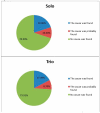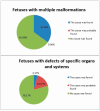Application of Whole-Exome Sequencing (WES) for Prenatal Determination of Causes of Fetal Abnormalities
- PMID: 40428369
- PMCID: PMC12111140
- DOI: 10.3390/genes16050547
Application of Whole-Exome Sequencing (WES) for Prenatal Determination of Causes of Fetal Abnormalities
Abstract
Fetal abnormalities are major issues in prenatal medicine. They affect the predicted pregnancy outcome and entail a risk of future recurrent adverse events in a particular couple. In order to clarify the possible outcomes of a specific pregnancy and subsequent ones, it is of the utmost importance to determine the causes of observed fetal abnormalities. Routine laboratory techniques sometimes fail to identify their cause because they are mainly intended for the detection of chromosomal disorders. Over recent years, single-gene disorders have increasingly been regarded as probable causes of fetal abnormalities, and next-generation sequencing (NGS) technologies have been adopted to detect them. This article provides the findings of applying whole-exome sequencing (WES) for prenatal diagnosis. It is aimed at identifying the causes of various fetus abnormalities with a normal molecular karyotype. The diagnostic value of this technique is shown based on the completeness of clinical patterns, abnormality types, and the ability to simultaneously examine the fetus and the parents. Consequently, WES revealed causative variants in 27.27% of cases, which encourages the consideration of applying this technique as part of a state-of-the-art multiple congenital malformation prenatal diagnosis algorithm.
Keywords: DNA; diagnosis; fetal abnormality; multiple congenital malformations; next-generation sequencing; prenatal; ultrasound; whole-exome sequencing.
Conflict of interest statement
The authors declare no conflicts of interest.
Figures
References
-
- Hillman S.C., McMullan D.J., Hall G., Togneri F.S., James N., Meller C.H., Williams D., Wapner R.J., Maher E.R., Kilby M.D. Use of prenatal chromosomal microarray: Prospective cohort study and systematic review and meta-analysis. Ultrasound Obstet. Gynecol. 2013;41:610–620. doi: 10.1002/uog.12464. - DOI - PubMed
-
- Callaway J.L.A., Shaffer L.G., Chitty L.S., Rosenfeld J.A., Crolla J.A. The clinical utility of microarray technologies applied to prenatal cytogenetics in the presence of a normal conventional karyotype: A review of the literature. Prenat. Diagn. 2013;33:1119–1123. doi: 10.1002/pd.4209. - DOI - PMC - PubMed
MeSH terms
LinkOut - more resources
Full Text Sources
Medical



